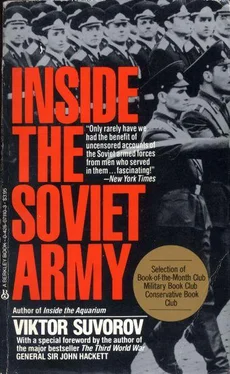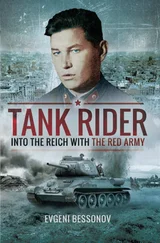About a third of the divisions in the Soviet Army fall into category A. They include all divisions stationed abroad and a number of divisions on the Chinese frontier.
Categories B and C, too, account for approximately a third of all Soviet divisions. In recent years there has been a constant shift of divisions from category B to category C, because of the introduction of such new arms of forces as airborne assault troops and fortified area troops. The new sub-units and units need entirely new troops, which are always taken from category B divisions. They cannot be taken from category A divisions, because these represent the minimum number of troops who must be kept at readiness, or from category C divisions because these have no one to spare.
It must also be noted that in category B divisions the three most important battalions-rocket, reconnaissance and communications are kept at category A strength. In category C divisions these battalions are maintained at category B strength.
The same applies to similar sub-units serving with Armies and Fronts. All rocket, reconnaissance, diversionary and communications sub-units of Armies and Fronts are maintained at a strength one category higher than that of all the other elements of the particular Army or Front.
4
It must be emphasised that the category allocated to a division has no effect whatsoever upon the extent to which it is supplied with new weapons. Divisions stationed abroad, which are all, without exception, in category A, take second place when new combat equipment is being issued.
The newest equipment is issued first of all to the frontier Military Districts-Baltic, Byelorussian, Carpathian, Far Eastern and Trans-Baykal.
Only five or seven, sometimes even ten years after a particular piece of equipment has first been issued, is it supplied to divisions stationed abroad. Third to be supplied, after them, are the Soviet Union's allies. Once the requirements of all these three elements have been fully satisfied, the production of the particular model is discontinued. Once production of a new version has begun, the re-equipment of the frontier military districts begins once again, and the material withdrawn from them is used to bring units located in the rear areas up to the required scale. Once the Soviet frontier military districts have been re-equipped, the process of supplying their used equipment to Category C divisions follows. Then the whole process begins again-to the second echelon, then to the first, then from the second via the first to the third.
Such a system of supplying combat equipment has undeniable advantages.
Firstly, secrecy is greatly increased. Both friends and enemies assume that the equipment issued to the Group of Forces in Germany is the very latest available. Enemies therefore greatly underestimate the fighting potential and capabilities of the Soviet Army. Friends, too, are misled and it therefore becomes possible to sell them a piece of equipment which is being issued in East Germany as if it were the most up-to-date model.
Secondly, it becomes far more difficult for a Soviet soldier to defect to the enemy with details of the newest equipment-or even, perhaps, to drive across the border in the latest tank or fighting vehicle. It is practically impossible to do this from the Baltic or Byelorussian Military Districts. The Soviet command does not worry at all about the Trans-Baykal or Far Eastern Military Districts. It knows very well that every Soviet soldier hates socialism and that he would therefore defect only to one of the capitalist countries. No one would ever think of defecting to socialist China.
Thirdly, in the event of war, it is the first echelon forces which would suffer the greatest losses in the first few hours-good equipment must be lost, of course, but it should not be the very latest. But then, after this, the Carpathian, Byelorussian and Baltic divisions go into battle equipped with the new weapons, whose existence is unsuspected by the enemy.
This system of re-equipment has been in existence for several decades. It is significant that the T-34 tank, which went into mass production as early as 1940, was issued only to military districts in the rear areas. Although the USSR was unprepared for Germany's surprise attack, these security measures were taken automatically, simple as they were to enforce. The surprise onslaught made by the Germans destroyed thousands of Soviet tanks, but there was not a single T-34 among them. Nor, despite the fact that the Soviet Army had some 2,000 of these tanks, did they appear in battle during the first weeks of the war. It was only after the first echelon of the Soviet forces had been completely destroyed, that the German forces first met the excellent T-34. It is also significant that German Intelligence did not suspect even the existence of that tank, let alone the fact that it was in mass production.
1
On 31 December, 1940, the German General Staff finished work on a directive on the strategic deployment of the Wehrmacht for the surprise attack on the USSR. A top-secret appendix to the directive was prepared from data provided by German Intelligence, containing an appreciation of the fighting strength of the Red Army. The German generals believed that the Soviet land forces possessed 182 divisions, of which only 141 could be brought into a War against Germany. Because of the tense situation on the Asian frontiers of the USSR, a minimum of 41 divisions must at all costs be left guarding these frontiers. The whole plan for the war against the USSR was therefore based on an estimate of the speed with which 141 Soviet divisions could be destroyed.
On 22 June Germany attacked, taking everyone in the USSR, Stalin included, by surprise. The way the war developed could not have been better for Germany. In the first few hours, thousands of aircraft were blazing on Soviet airfields while thousands of Soviet tanks and guns did not even succeed in leaving their depots. In the first days of the war, dozens of Soviet divisions, finding themselves encircled and without ammunition, fuel or provisions, surrendered ingloriously. German armoured spearheads carried out brilliant encirclement operations surrounding not just Soviet divisions or corps but entire Armies. On the third day of the war the 3rd and the 10th Soviet Armies were surrounded near Bialystok. Immediately after this an equally large encirclement operation was carried out near Minsk, Vitebsk and Orsha, near Smolensk. Two Soviet armies were destroyed after being surrounded near Uman' and five Armies in a huge pocket near Kiev.
However, already, even while the bells were ringing for their victories, the sober-minded German generals were biting their fingernails, as they bent over maps; the number of Soviet divisions was not diminishing-on the contrary, it was rising fast. Already in mid-August General Halder was writing in his diary: `We underestimated them. We have now discovered and identified 360 of their divisions! But Halder was only talking about the Soviet divisions which were directly involved at that moment in fighting in the forward areas-that is, first echelon divisions. But how many were there in the second echelon? And in the third? And in the reserves of the Armies and the Fronts? And in the internal military districts? And in the Stavka's reserve? And how many divisions had the NKVD? How many were there in all?
The miscalculation proved fatal. 153 German and 37 allied divisions proved insufficient to destroy the Red Army, even given the most favourable conditions.
The German generals' miscalculation was twofold. Firstly, the Red Army consisted, not of 182 but of 303 divisions, without counting the divisions of the NKVD, the airborne forces, the marine infantry, the frontier troops, the Fortified Area troops and others.
Читать дальше












